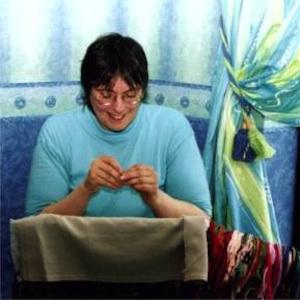- Home
- Cross stitch on evenweave fabric
Counted Cross Stitch on
linen and evenweave fabrics
Are you ready to take your counted cross stitch skills to the next level?
If you've tried my tutorial on Aida fabric, and want to try something new, it's time to consider counted cross stitch on linen or evenweave. These fabrics offer a whole new experience for stitchers, and I can't wait to tell you all about it!
Now, don't get me wrong, Aida cloth is fantastic for beginners and easy to stitch on. But if you're looking for a more polished and refined look, evenweave or linen fabrics are the way to go. These fabrics have a finer weave, resulting in a less blocky appearance to the background of your counted cross stitch piece.
Just take a look at the photographs below. On the right, we have a cross stitch on Aida fabric, and on the left, a cross stitch on evenweave. Can you see the difference? The evenweave fabric gives the design a more delicate and elegant look.
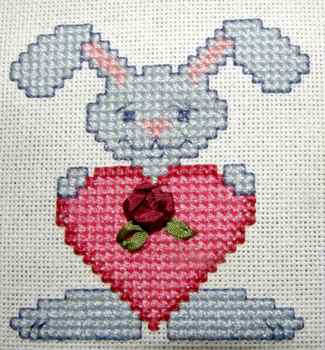
Evenweave
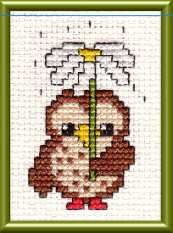
Aida
Don't let the fear of stitching on different fabrics hold you back!
Many beginners think that working counted cross stitch on linen or evenweave is difficult, but that couldn't be further from the truth.
It's all about training your eye and getting used to stitching over two threads instead of a solidly woven block. And let me tell you, once you start working on cross stitch patterns with fractional stitches, you'll never want to go back to Aida. No more struggling to force a blunt needle through the centre of a tightly woven block.
With linen or evenweave, it's a breeze!
What supplies will you need?
As much as I love embroidery, my eyes aren't as young as they used to be. I prefer to use a magnifying lamp so I can easily tackle those higher fabric counts without eye strain. It's like having a personal spotlight right on my project, making sure I never pick up the wrong floss colours by mistake.
Once you try one, you'll wonder how you ever stitched without it! And if you haven't gotten your hands on one yet, don't worry. Just find a spot with plenty of natural light, and you'll be good to go.
Make it easier on yourself when using black evenweave - lay a white pillowcase on your lap to make the holes easier to see!
If you don't already own an embroidery hoop, it's time to invest in one!
Imagine the frustration of trying to stitch on loose fabric. It's like trying to paint on a canvas that's not stretched. But with an embroidery hoop, you'll have a smooth and even surface to work on.
I've even written a whole page on embroidery hoops, that gives you all the information you need to make an informed decision on choosing the right size and type.
When it comes to needles for counted cross stitch on evenweave, you'll want to find ones that are finer, allowing them to effortlessly glide through the fabric without causing any distortion. Tapestry needles with their blunt points are perfect for this, as they prevent you from accidentally piercing the threads. I recommend going for size 26 or even 28 needles.
The counted cross stitch count conundrum

Sometimes, people get a little confused when it comes to cross stitching on evenweave fabric. They wonder if it will change the size of their finished design.
When you cross stitch on evenweave fabric, you typically work over two fabric threads. So, to figure out the equivalent size in Aida fabric, you just need to halve the number of fabric threads per inch. It's as simple as that!
Let me give you an example. Say you have a chart that specifies the size when using 14 count Aida fabric. But you decide to stitch it on 28 count linen instead. No problem. Your finished project will still end up the same size!
Now, I know things can get a bit tricky when the halved thread count doesn't match what's shown in your cross stitch kits. But I have a secret weapon for you - my magic cross stitch calculator! This handy tool will help you figure out the right thread count for your project.
And here's another exciting thing. Since your stitching will end up the same size, you can keep on splitting those six strands of embroidery floss and stitch with just two.
Working counted cross stitch over two threads
Evenweave fabric is woven in a special over/under method, creating a weave that's perfect for hand embroidery.
When you examine the vertical threads, you'll notice that some go over the horizontal ones, while others lay below. It's important to start stitching beside an "over" thread to ensure that your stitches don't slip underneath.
When you begin your cross stitch next to a vertical thread, you can easily see if you've accidentally skipped a stitch or made a wonky one, and you can fix it before it becomes a bigger problem. It's like having a built-in safety net for your embroidery!
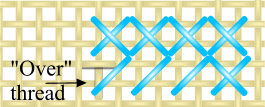
To help you visualize this, let's imagine a tic-tac-toe board.
Picture two lines going horizontally and two lines going vertically, giving you nine places to put your cross or nought. Now, imagine replacing these lines with fabric threads. Voila! You now have nine places where you could put your needle.
However, in most cases, we only use the four corner holes, leaving one empty on each side and one in the centre.
So, you've brought your needle up in the correct hole.
We're going to take a diagonal stitch "over 2". This means we'll skip the first hole and use the second one instead. As a result, we'll have an empty hole in the centre of our stitch.
Then, bring the needle back up two holes down to form the bottom right-hand corner of our cross stitch.
To complete the stitch, skip the central hole again and go down in the next hole diagonally. Congratulations, you've just completed your first cross stitch on evenweave!
The method of working cross stitch on linen that I described above is known as the English method. This technique involves working one stitch at a time. However you can speed things up.
By working the bottom stitch across the row and then crossing these on your way back you are using the continental method. There is nothing to stop you using both ways of doing things in the same cross stitch project.
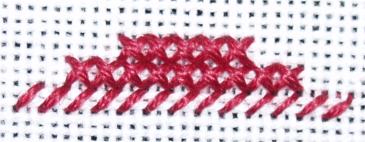
When it comes to keeping track of my progress on a chart, I've found the perfect tool: a trusty highlighter. As I work each stitch, I mark it off, turning the chart into a mosaic of colour.
Stitching fine details
Have you heard the term petit point?
This technique is like a secret weapon for adding intricate detail to your designs. Imagine stitching not just one "normal" counted cross stitch, but four smaller crosses in its place. That's the magic of petit point! It's like zooming in on your embroidery to capture even the tiniest features.
You'll sometimes find petit point used in cross stitch patterns to bring little faces to life or to add delicate fingers to tiny hands. It's incredible how these tiny stitches can make such a big difference, adding that extra level of realism and charm to your work.
Trying to stitch petit point on Aida is a challenge, since it involves piercing the centre of the woven block with a sharp needle.
Finding that exact centre point is locating that elusive exact centre point is no easy feat. It requires a keen eye and a steady hand, for any slight deviation will be glaringly apparent in your final masterpiece.
When using evenweave or linen fabric this is not an issue.
In summary
I hope you found this information on working counted cross stitch on evenweave helpful! By giving it a try, you will have the opportunity to discover if you have a preference for these types of fabrics or if you prefer working on Aida cloth. Either way, you'll be diving deeper into the wonderful world of hand embroidery!
Stay connected between projects
If you’d like occasional updates from my embroidery room, including new patterns, gentle tips, and little things I think you might enjoy, you’re warmly invited to join the Stitchin’ Times newsletter.
No pressure. Just a friendly note now and then to keep you inspired.

